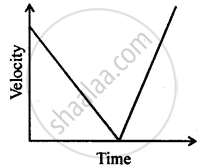Advertisements
Advertisements
प्रश्न
When a car driver travelling at a speed of 10 m/s applies brakes and brings the car to rest in 20 s, then retardation will be :
विकल्प
+ 2 m/s2
− 2 m/s2
− 0.5 m/s2
+ 0.5 m/s2
उत्तर
+ 0.5 m/s2
The term “retardation” means negative acceleration.
Initial velocity = 10 m/s
Final velocity = 0 m/s
Time taken = 20 s
Acceleration = `"0-10"/20`
⇒ Acceleration = `-0.5 "m/s"^2`
⇒ Retardation = 0.5 `"m/s"^2`
APPEARS IN
संबंधित प्रश्न
A bus decreases its speed from 80 km h−1 to 60 km h−1 in 5 s. Find the acceleration of the bus.
Name the quantity which is measured by the area occupied under the velocity-time graph.
A train starting from stationary position and moving with uniform acceleration attains a speed of 36 km per hour in 10 minutes. Find its acceleration.
A boy is sitting on a merry-go-round which is moving with a constant speed of 10 m s−1. This means that the boy is :
A freely falling object travels 4.9 m in 1st second, 14.7 m in 2 nd second, 24.5 m in 3rd second, and so on. This data shows that the motion of a freely falling object is a case of :
A body starts from rest and acquires a velocity 10 m s-1 in 2 s. Find the acceleration.
The figure shows the displacement - time graph for four bodies A, B C and D. In each case state what information do you get about the acceleration (zero, positive or negative).

Can you suggest a real-life example about the motion of a body from the following velocity – time graph?

A packet is dropped from a stationary helicopter, hovering at a height ‘h’ from ground level, reaches the ground in 12s. Calculate
- the value of h
- final velocity of packet on reaching the ground. (Take g = 9.8 ms−2)
Two stones are thrown vertically upwards simultaneously with their initial velocities u1 and u2 respectively. Prove that the heights reached by them would be in the ratio of `"u"_1^2 : "u"_2^2` (Assume upward acceleration is –g and downward acceleration to be +g)
